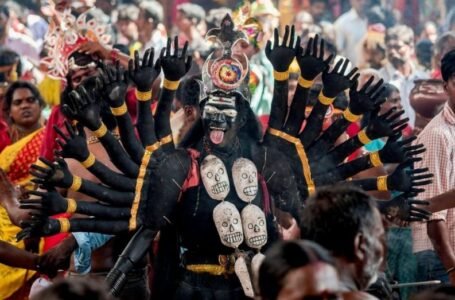Bhuvaneshwari: The Queen of the Universe
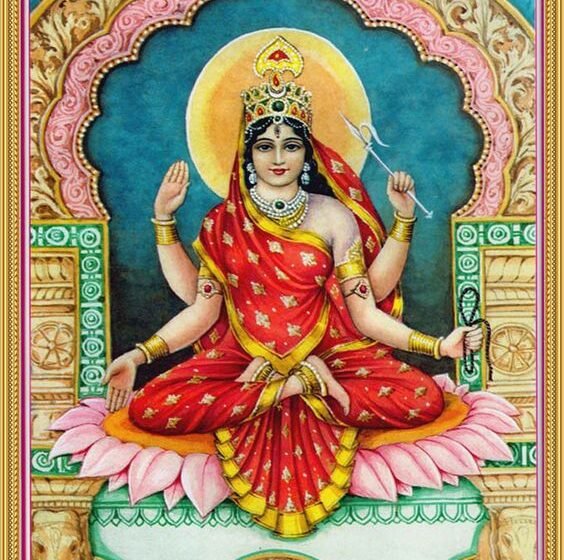
Goddess Bhuvaneshwari, lovingly called Bhuvaneshwari devi is the fourth goddess in the ten Mahavidyas of Shaktism. She is said to be the Mahadevi. Bhuvaneshwari is a compound word, consisting of two words Bhuvanam and Ishwari. Bhuvanam means all the worlds of the cosmic universe, whereas Ishwari means the feminine principle of a lord or the ruler. Her name in the literal sense translates into the Queen of the Universe and the ruler of the three worlds, heaven, earth, and space, or the creator as well as the sustainers of all cosmic universes. Within Shaktism, Bhuvaneshwari is said to be the manifestation of the fierce goddess Kali.
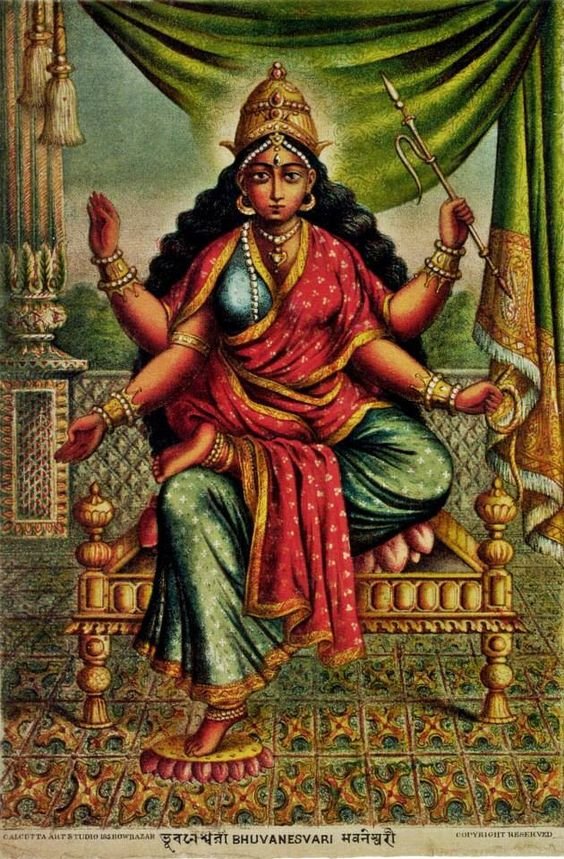
Bhuvaneshwari is often portrayed in her iconography as a beautiful woman with a gentle and compassionate expression. She mostly has four arms, her two arms holding a noose and a goad, while the other two arms of her are usually positioned in gestures or mudras of blessings and protection. The emblem of noose symbolizes her ability to bind devotees to her with love and compassion. The goad on the other hand, represents her power to remove obstacles and steer the believers towards spiritual growth. In her portrayals of Hindu iconography, Bhuvaneshwari devi is often shown adorned in red garment. The red colour of her attire stands as a symbol of her connection with the vital life force and her creative energy. Her skin is often golden, unlike her manifestation of Kali that is dark in skin colour, this golden-ish tone of her skin serves as a status of her supreme divinity and brightening nature.
Her mount is a lotus, which stands as a symbol of purity and spiritual enlightenment; in some depictions the devi is portrayed as sitting on a throne, signifying her status as the queen of the universe. In her portrayals, like the goddesses’ of Dasa Mahavidyas, she too has a vertical third eye in the centre of her forehead, and sometimes a crescent moon appears in place of the third eye. Her third eye represents her ability to see beyond the material realm, and the crescent moon draws on her connection with time and the cyclical nature of creation. Her depictions attest to her role as the queen of the universe who governs all the three realms with utmost compassion and divine wisdom.

In one popular legend, during the beginning of time, when there was no creation, there existed on a vast dark and formless void. It is believed in Hinduism that from this void emerged the luminous and beautiful Bhuvaneshwari, who possessed in her being the potential to create the universe and other creation. She used her divine energy, creating the essential elements, planets and living beings, bringing order and harmony to the cosmos. This legend goes onto emphasize Bhuvaneshwari’s role as the queen or mother of the universe, whose creative powers gave rise to all existence.
In another version of the legend, in the heart of cosmic darkness, where there was neither form nor distinction, the sun god Surya emerged, his radiant light piercing the void and illuminating the universe. Surya was moved by the devotion and asceticism of ancient sages decided to create the three worlds: heaven, earth, and the underworld. This creation was an act of divine grace, aimed at bringing order and structure to the previously chaotic and shaken cosmos. As a token of gratitude and to ensure the safety and harmony of the newly formed worlds, the Supreme Energy, also known as Adi Shakti assumed the form of Bhuvaneshwari. She became the cosmic queen, embodying the divine feminine energy responsible for creation, preservation, and transformation. She with her compassion and wisdom ensured the balance and continuity of cosmic processes.
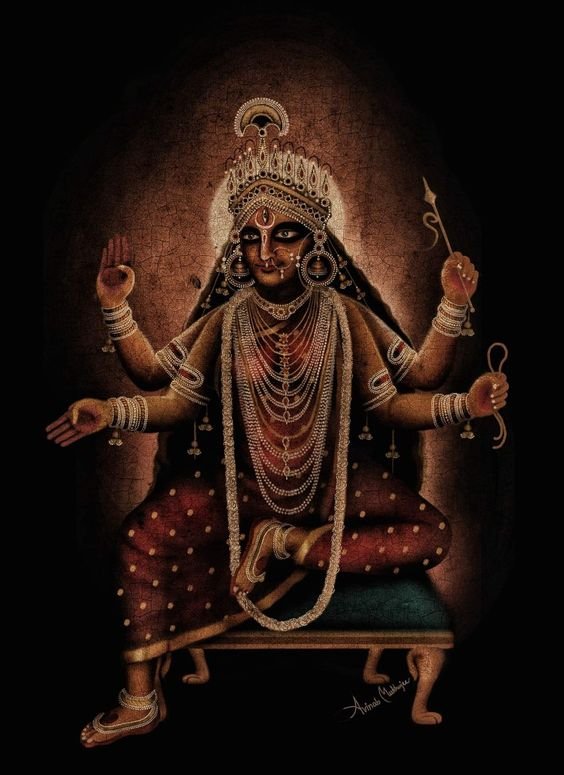
Another important account of the goddess’s myth, tells the tale of her request to the Lord Brahma the creator deity and one of the Trimurti. It is said that Bhuvaneshwari approached Lord Brahma with a desire to govern the entire universe. Recognizing her divine potential and boundless energy, Brahma granted her wish, endowing her with the embodiment of the universe itself. This bestowed upon her the supreme authority and responsibility over all creation, making her the sovereign ruler of the cosmos. Bhuvaneshwari devi is also linked to the Varaha Avatar of Lord Vishnu. In this incarnation, Vishnu assumed the form of a boar to rescue the earth, which had sunk into the cosmic ocean. Using Bhuvaneshwari’s iccha shakti, Vishnu made the earth fertile and vibrant once again. This tale highlights Bhuvaneshwari’s role in sustaining and nurturing life within the cosmic universes.
However, Bhuvaneshwari is not just a goddess of earthly domains but possesses the very fabric of universe. She has the essence of space and time, and the foundational elements that support all creation. In her cosmic form, she represents the vast expanse within which galaxies, stars, planets, and all living beings exist. Her universal aspect acts as a reminder and guidance for the devotees of the interconnectedness and unity of all life forms of the cosmic universe. In Hindu cosmology, Akasha—space—is considered the first element to manifrst during the process of creation. Bhuvaneshwari as the incarnation of Akasha, represents the infinite and formless expanse that serves as the stage for all cosmic events. Bhuvaneshwari, therefore, upholds and sustains the universe.
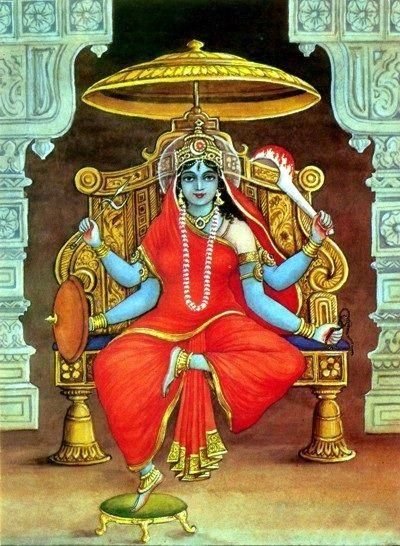
Bhuvaneshwari is worshipped in several prominent temples across India, including the Bhuvaneshwari Temple in Kollur, Karnataka and the Bhuvaneshwari Temple in Puducherry. These temples attract thousands of pilgrims from across India, who come to seek the goddesses’ blessings and participate in the rituals associated with her. In these temples of the goddess extensive rituals are performed daily to honor her. These rituals include the offering of flowers, fruits, and sweets, while the mantras and hymns praising the devi are chanted. Devotees participate in pujas and fire rituals to seek her blessings and protection. These rituals are said to purify the devotees mind and soul, aligning them and guiding them to see beyond the material realm and understand the cosmic universe.
Bhuvaneshwari is celebrated on Bhuvaneshwari Jayanti, an occasion that marks the goddesses’ appearance day. On this day her devotees worship her with rituals, prayers and gatherings. Temples hold cultural and spiritual activities, including narrations of her myths, legends and significance, to incite deep devotion in the hearts of the devotees. The queen of the universe’s influence goes beyond the myths and temples and extends into modern day yoga practices. In these practices her energy is invoked upon for spiritual growth and self realization. Certain asanas or yoga postures are performed and breathing exercises are conducted with the sole intention of summoning the devi’s cosmic energy. It is believed by performing specific asanas and pranayama, an individual can seek a balance between the physical, mental, and spiritual aspects that will ultimately harmonize them with the universe that she represents.
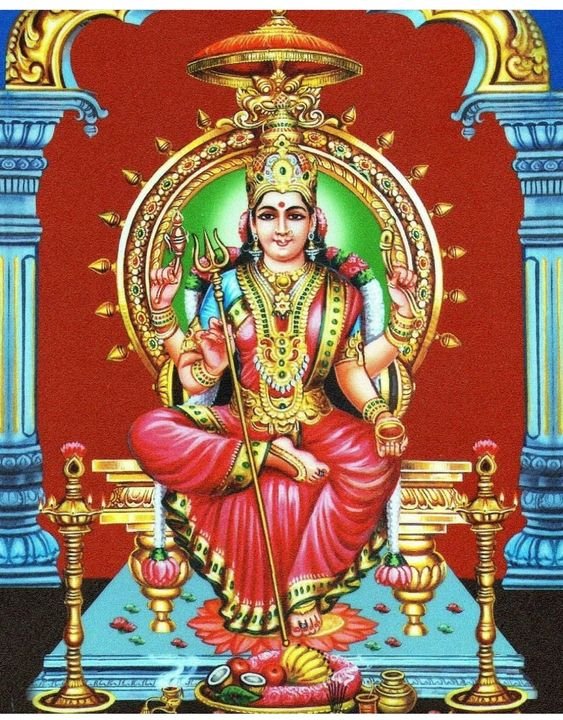
Bhuvaneshwari, as the fourth Mahavidy, is a goddess of the universe and holds an important place in the pantheon of Hindu deities. Her attributes as the cosmic queen, a nurturing mother and the personification of the creative power symbolize the concepts of space, creation, and divine feminine energy. Through her worship and invocation, devotees seek for themselves a unity with the cosmic order and to attain enlightenment. She in her status as the queen of the universe holds the principle of love, compassion, and wisdom, attesting to her being as the creator, sustainer and the sovereign ruler of the three cosmic worlds.

